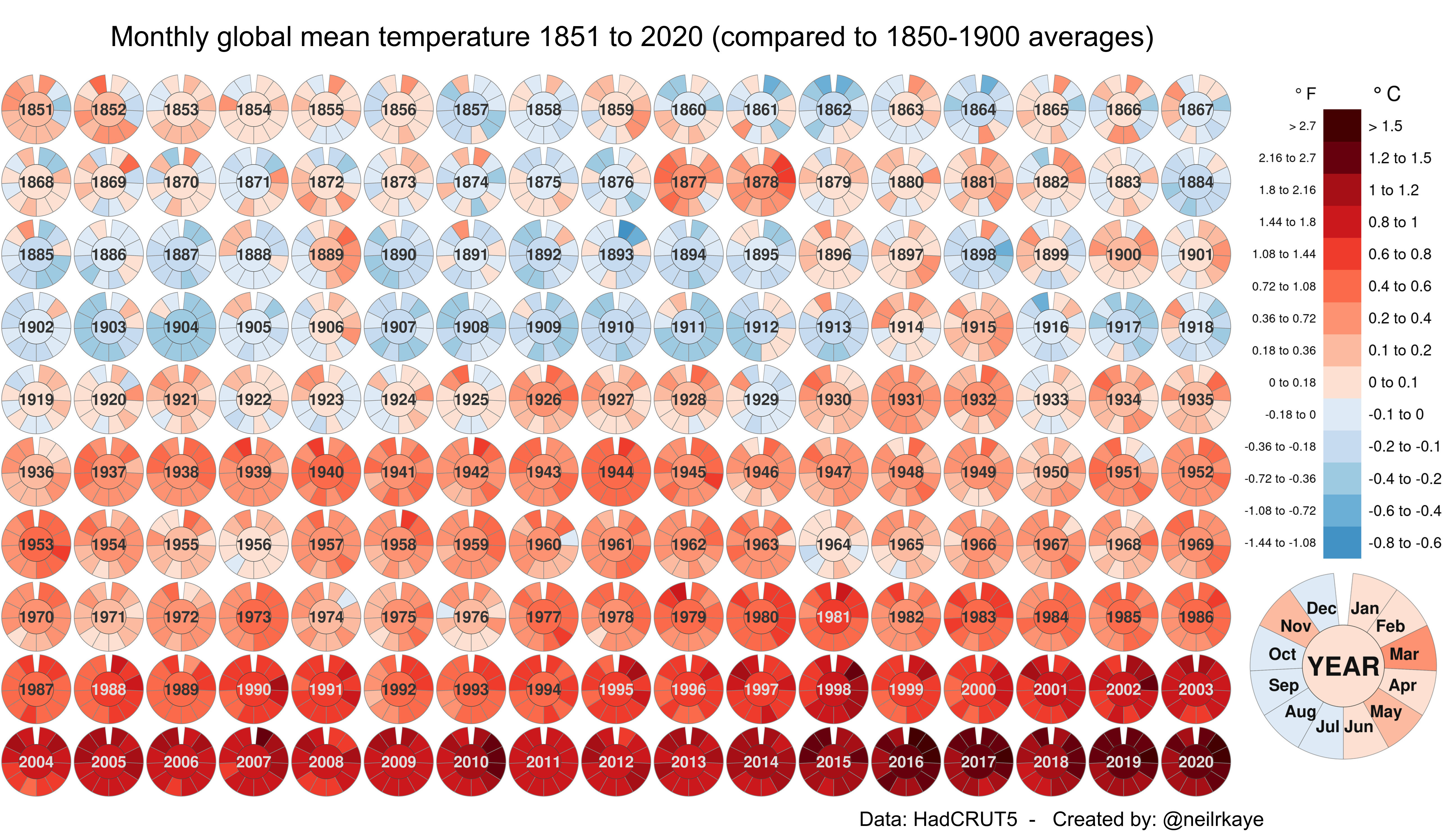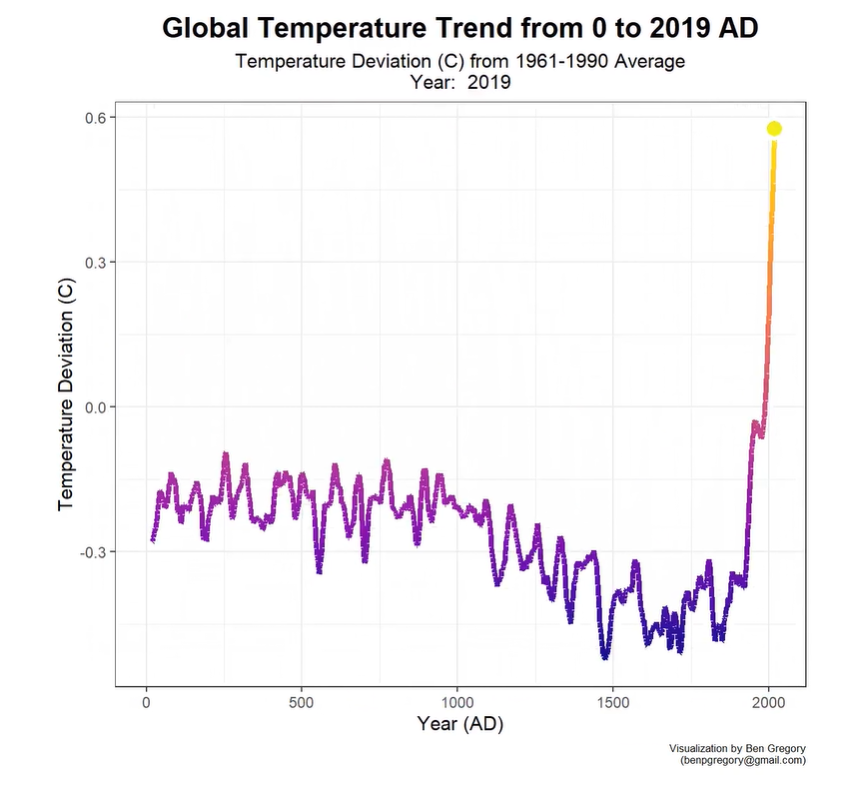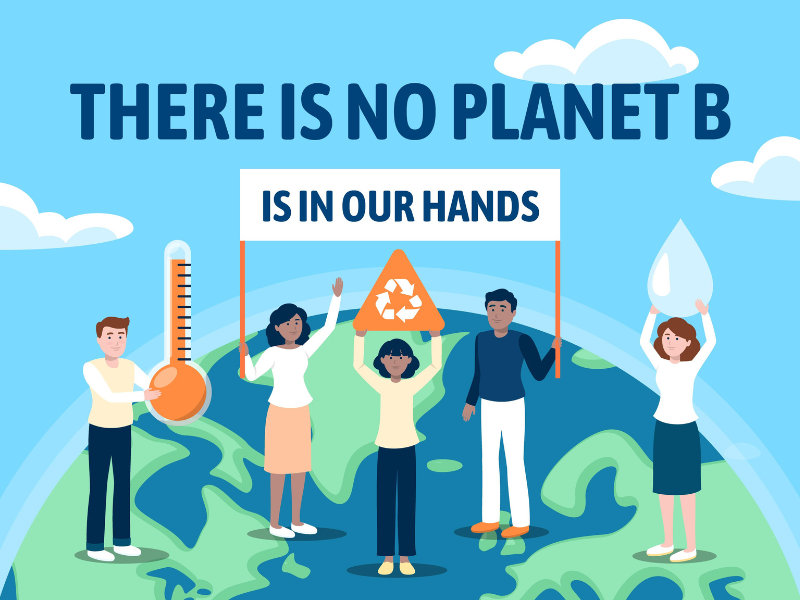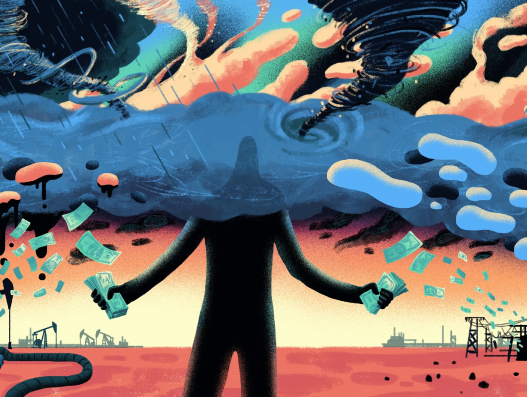Here’s a Graph Showing the Temperatures Around the World (1851-2020)

Since the beginning of the industrial revolution, surface-level average temperatures have been more than 1.5 degrees Celsius higher than their pre-industrial values. Image: “The Visual Capitalist” (photograph)
Temperatures at the earth’s surface have risen at an average rate of 0.07 degrees Celsius (0.13 degrees Fahrenheit) every decade for the past 130 years since 1880. Although each component may not appear to be particularly significant on its own, the total will, over time, become increasingly important.
Temperature swings have been more extreme over time, with the rate having more than doubled to 0.18 degrees Celsius (0.32 degrees Fahrenheit) since 1981. The environmental catastrophes that have arisen as a direct result of the ongoing process of global warming have emerged as the primary dangers that humanity is currently confronted with.
Neil R. Kaye, a climate data scientist, developed this graph to illustrate the average monthly temperatures across the globe over the past approximately 170 years. Temperature measurements have been compared to the pre-industrial averages, which have been utilised as a reference point (1850–1900).
Why is the temperature of the globe increasing?
The representation of the data is divided into two sections, and each of these parts indicates a significant turning point in the trend of global warming:
- Convergence with the Age of Machines, 1851–1935 [1851–1935]
The predicted increase in average global temperature might range anywhere from -0.4°C to +0.6°C. - Convergence with the Emerging Industrial Age, 1936–2020
Temperature increase over the globe, from the low end to the high end: +0.6°C to +1.5°C and up
According to the graph that displays global temperatures, the global average surface temperature has been consistently more than 1.5 degrees Celsius higher than its pre-industrial levels for several years. Let’s investigate these periods in greater depth to understand this incident’s historical context better.
Alterations and progress made in the manufacturing sector between the years 1851 and 1935
There is a remarkable optical abnormality that occurs between the years 1877 and 1878, and it merits more examination. This historical period witnessed a series of extreme climate events that had never happened before in the history of humanity. These events ranged from a strong El Nio to widespread droughts. The Great Famine was responsible for the deaths of between 19 and 50 million people, making it more lethal than even the pandemics with the highest death toll in recorded history.
The first five rows of the graph depicting global temperature, several different economies began the Second Industrial Revolution (1870–1914). This was followed by World War I in the sixth row (1914-1918). Over the past eighty years, a strong emphasis was placed on the manufacturing of steel and mass-produced consumer goods.
These technological advancements undoubtedly benefited society; however, they came at the expense of burning fossil fuels, which led to a significant increase in the concentration of carbon dioxide and other greenhouse gases in the atmosphere. This trade-off had to be made to fund these technological advances. It would be decades before scientists fully comprehend the implications of their accumulation in the atmosphere and the connection between that and a general global rise in temperature.
The world from the 1930s up until the 2020s, often known as the Red Zone
The second section of the temperature graph for the world shows the effects of World War II (1939-1945), which can be seen in the third column. As soon as the haze had cleared, countries immediately began the process of rebuilding, and the Third Industrial Revolution kicked the recovery into high gear.
People and things have travelled further than ever since the 1950s, roughly concurrent with the beginning of the modern era of globalisation and commercialisation. In addition, between the years 1965 and 1970, the annual population growth rate averaged a staggering 2.1%. The pace of industrialisation began to quicken as a response to the growing demands of the contemporary world and the ever-increasing population worldwide.
The relevance of past temperature patterns to current conditions
The effects of climate change have been felt throughout human history. The progression of historical trends can shed light on the question of how much of the recent rapid increase in global average temperatures during the past 85 years may be related to natural patterns of climate change as opposed to activities carried out by humans.
A member of Reddit named bgregory98 developed the following graph using a big data set published in Nature Geoscience to more vividly the argument. The rise in global temperatures has received much attention over the past two thousand years. Within this broad time frame, the most recent decade alone is responsible for producing eight of the top ten warmest years on record.
This graph demonstrates that there has been a significant increase in average world temperature over the past two thousand years.

Image: “The Visual Capitalist” (photograph)
Global warming and climate change are two essential megatrends expected to emerge shortly. However, promising steps are being taken, such as the United States rejoining the Paris Climate Agreement and the reduction of global carbon emissions being designated a prominent topic at the World Economic Forum’s Davos Summit 2021. Both of these events will take place in 2021.
Think about this:
Climate change is hurting human life, urban areas, and ecological systems. As a result of human-caused global warming, extreme weather, ranging from heatwaves and droughts to cyclones and floods, is becoming more common, severe, and unpredictable. Because of ocean warming and acidification, coral bleaching events occur twice as frequently as in 1980, and many corals are dying as a result—the more dangerous the climate, the greater the threat to ecosystems and human societies. Even 1.5°C of global warming will make it difficult for the planet to survive. However, the 1.5°C to 2°C warming range is a critical battleground in which threats to human civilisation and ecosystems multiply rapidly.
To progress, we must accept that we will need to make significant changes to our way of life. Transitioning will be difficult, but it is necessary to protect future generations and our species and natural environments. There is far too much at stake to wait until next year to act.




